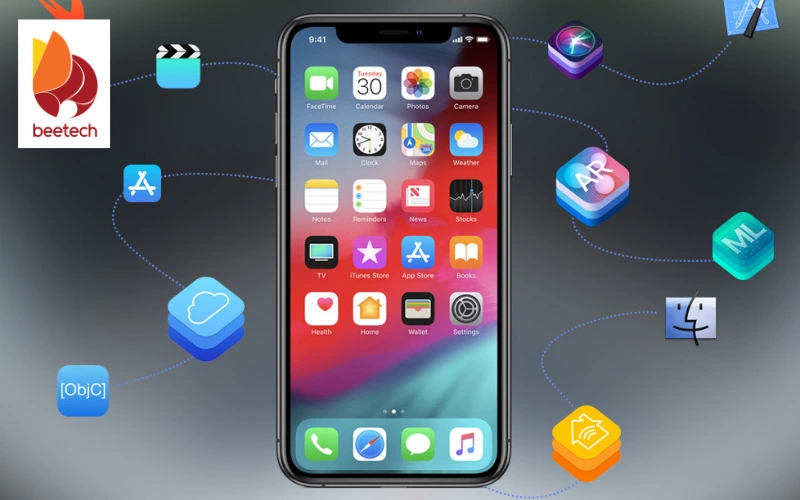Mobile App Development Process in Vietnam
Mobile app development is becoming a key trend, helping businesses reach customers faster and improve operational efficiency. In Vietnam, more companies and startups are investing in this field due to its great potential and high-quality tech workforce. So, what are the essential steps in the mobile app development process? Which trends will lead the market in 2025?

1. Overview of mobile app development
In the digital era, mobile app development is not just a trend but a crucial strategy that enables businesses and individuals to reach customers more effectively, enhance user experience, and unlock new business opportunities.
1.1. The boom of the mobile application market in Vietnam
In recent years, mobile application development has become a crucial trend in Vietnam. With over 70% of the population using smartphones, the mobile application market is growing rapidly, especially in sectors such as e-commerce, financial services, healthcare, and education.
>>> Read more: What is the most common software development life cycle (SDLC)?
According to statistics, Vietnam is among the fastest-growing countries in Southeast Asia in terms of mobile application growth. Businesses, from startups to large corporations, are investing heavily in mobile application development to enhance customer engagement. With the support of 5G technology, AI, and Big Data, applications are becoming increasingly intelligent, personalized, and convenient.
1.2. Mobile applications in business and daily life
Mobile applications are not only entertainment tools but also essential in business operations and daily life. Prominent sectors include:
Entertainment & Media: Platforms like TikTok, Zalo, YouTube, and Spotify have become increasingly popular, allowing users to access content quickly.
E-commerce: Shopee, Tiki, and Lazada are prime examples of the boom in mobile application development for online shopping.
Financial technology (Fintech): Apps like MoMo, ZaloPay, and Viettel Money are transforming how Vietnamese people make payments and manage finances.
Healthcare & Education: Telehealth and e-learning have become trends with the rise of applications supporting remote medical consultations and online learning.
Owning a mobile application allows businesses to connect with customers more easily, optimize sales processes, enhance user experience, and boost revenue effectively.

1.3. Key factors for a successful mobile application
To attract and retain users, businesses must focus on the following factors:
User experience (UX/UI): A well-designed, easy-to-use interface that optimizes interactions makes an application more user-friendly.
Useful features: The app must address real user needs while avoiding unnecessary complexity.
Stable performance: The application should run smoothly without crashes or lag.
High security: Ensuring user data protection is critical, especially for financial applications.
Effective marketing strategy: Combining advertising, App Store Optimization (ASO), and promotional programs to attract users.
With technology continuously improving, mobile app development in Vietnam remains a promising trend. Businesses and individuals can seize this opportunity to create high-quality products that enhance user experience and achieve long-term success.
2. Mobile app development trends in 2025
With the continuous advancement of technology, the mobile app development industry is experiencing significant changes, bringing new and more convenient experiences to users. Below are the key trends that will dominate the mobile app market in 2025.
2.1. Super mini-apps: Integrating multiple features into one compact app
In 2025, super mini-apps will be a major trend. Instead of downloading multiple apps, users can use one app that includes various features such as shopping, payments, entertainment, and work-related tasks. This saves phone storage while ensuring that all customer needs are met quickly and conveniently.
>>> Read more: Evaluating software outsourcing services in Vietnam
2.2. AI & Machine learning in mobile apps: Personalizing the user experience
With the advancement of Artificial Intelligence (AI) and Machine Learning, mobile apps will become smarter. They will learn from users' habits and provide personalized recommendations. For example, shopping apps will suggest products based on your preferences, saving you time and enhancing your shopping experience.
2.3. Instant apps: Experience without installation, saving storage space
Instant apps allow you to try an app immediately without the need to install it. This is extremely useful when you only need to use an app once and don’t want to take up phone storage. With the development of 5G networks, these apps will offer a smoother and faster experience.

2.4. Security & Privacy: Ensuring user safety
Security and privacy are always critical when using mobile apps. App developers will need to ensure that users' data is kept safe. Technologies like data encryption and two-factor authentication will help protect customer privacy, making the app more reliable and trustworthy.
2.5. 5G & AR/VR technology: Enhancing user interaction
The 5G network will make mobile app usage faster and smoother. Alongside this, Augmented Reality (AR) and Virtual Reality (VR) technologies will provide new experiences, such as trying on clothes online or playing virtual reality games directly on your phone. These technologies will not only serve entertainment but also assist in work and learning.
3. Mobile app development process in Vietnam
To successfully develop a mobile app, you need to follow a structured process from idea conception, and design, to programming and deployment. Below are the specific steps that will give you a clearer understanding of each important stage in this process.
3.1. Step 1: Research & Idea generation
Before diving into mobile app development, it’s crucial to have a clear plan in place.
Market analysis and Targeting target customers: First, you must understand who will use your app. Market research helps you identify customers' needs and what they are looking for in an app.
Define business goals and core values of the app: You need to answer the question: What will this app do for your business? Will it increase revenue, enhance brand awareness, or improve customer service?
Create wireframe & User flow: This step involves drafting the app’s basic design. A wireframe is a sketch of the app's layout, while a user flow maps out how users will interact with each feature of the app.
3.2. Step 2: UI/UX Design – User experience
Once the idea is clear, the next step is to design the interface and user experience.
Create a visual interface optimized for specific user behavior: The app’s interface needs to be user-friendly and easy to navigate. Colors, images, and buttons should be arranged logically, so users can find what they need quickly.
Choose a design style that matches your brand: The design should reflect your brand’s values and personality. Choosing the right design style will help users identify and connect emotionally with your app.
Prototype testing: Before development, creating prototypes will allow you to test the design and see if it’s truly user-friendly. This step helps gather early feedback and adjust the design if necessary.
3.3. Step 3: Coding & App Development
When the design is finalized, the next step is coding and development.
Choose the right technology: Native (Swift, Kotlin) or Hybrid (Flutter, React Native): Depending on the business requirements, you’ll choose the appropriate development technology for your app. Native development provides smooth performance for each operating system (iOS or Android), while hybrid technology (like Flutter or React Native) allows for building cross-platform apps.
Build the backend and database: The backend serves as the foundation for the app, managing all data storage and user interactions. You also need to ensure the database is stable and efficient.
Ensure app performance and scalability: A good mobile app must run smoothly and without lag. Additionally, as the app grows and attracts more users, it should be able to scale effectively to handle increased demand.
3.4. Step 4: Testing & Refinement
Before releasing the app to users, testing is essential.
Functional testing & Performance testing: You need to test each feature to make sure everything works as expected, from login to payment systems and push notifications.
Test compatibility across devices & Operating systems: Your app must work seamlessly across all devices and operating systems, including iPhones, Android devices, and tablets.
Security testing and bug fixing: Security is a critical aspect of mobile app development. Ensure that user data is protected and that any bugs or vulnerabilities are fixed.
3.5. Step 5: Launch & Publish on App Store/Google Play
Once the app is ready, the final step is to get it to your users.
Register a developer account & Optimize ASO (App Store Optimization): To publish the app on platforms like the App Store or Google Play, you need to register as a developer and optimize your ASO to ensure users can easily find your app.
Create a marketing plan for the app: You’ll need a strategy to promote your app, from advertising on social media to collaborating with influencers or running paid campaigns.
Monitor user feedback and update features: After the app is launched, it's important to monitor user feedback and make regular updates to improve features and enhance the user experience.
Conclusion
Mobile app development plays a crucial role in the growth of the digital economy in Vietnam. By following a professional development process and leveraging advanced technologies, Vietnamese software companies can optimize performance and expand clients’ market reach. This presents a significant opportunity to create innovative products that meet the increasing demands of users.
